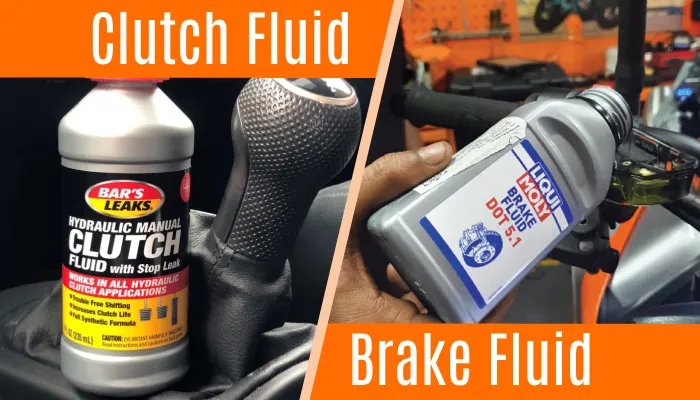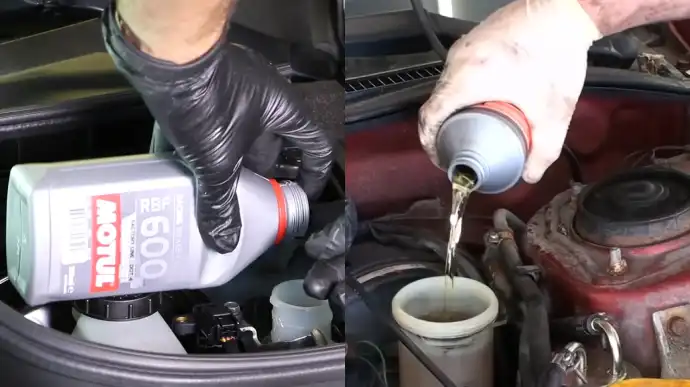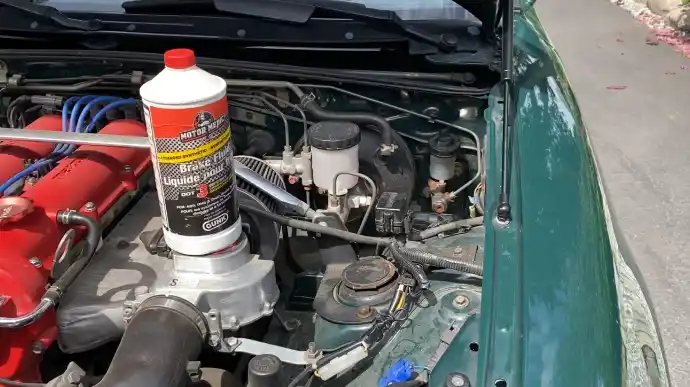Physical Address
304 North Cardinal St.
Dorchester Center, MA 02124
Physical Address
304 North Cardinal St.
Dorchester Center, MA 02124

Brake fluid and clutch fluid are two important hydraulic fluids in automotive engineering and maintenance. While they share the commonality of being hydraulic fluids, each serves a specific purpose and is tailored to the unique demands of its respective system.
Although clutch and brake fluids typically form the same oil, they serve different purposes. Clutch fluid engages and disengages the clutch mechanism, while brake fluid facilitates braking.
The boiling point of clutch fluid needs to be around 265°C to withstand the heat generated during clutch operation. Brake fluid requires a higher boiling point (400°F to 600°F or 204°C to 316°C) to withstand the heat generated during braking.
Here, we will explore the distinctions between clutch and brake fluid, answering these questions and more. If you’re wondering about the appropriate fluid for your vehicle’s clutch, keep reading to find out.

Several key points must be considered when understanding the differences between clutch and brake fluid in your vehicle.
Brake fluid is specifically designed to facilitate force transfer from the brake pedal to the brake calipers. This allows the vehicle to slow down or come to a complete stop by squeezing the brake pads against the rotors.
Conversely, clutch fluid, also known as hydraulic clutch fluid, engages and disengages the clutch. The driver can shift gears by transmitting force from the clutch pedal to the clutch mechanism.
Brake fluid is typically glycol-based, such as DOT 3, DOT 4, DOT 5.1, or silicone-based, like DOT 5. These different types have varying boiling points and chemical properties.
Clutch fluid, on the other hand, is often the same as the brake fluid used in the vehicle. Therefore, its composition depends on what kind of brake fluid you use.
The boiling points of clutch and brake fluid, previously discussed in terms of composition, play a crucial role in the performance and safety of your vehicle’s hydraulic system.
Brake fluid has a high boiling point, usually ranging between 400°F to 600°F (204°C to 316°C). This high boiling point is necessary because the braking process generates significant heat.
Similarly, clutch fluid requires a high boiling point, around 265°C, to withstand the heat generated during clutch operation. You can lose hydraulic pressure if either fluid’s boiling point is too low, which reduces your vehicle’s braking and clutch effectiveness.
Brake fluid can come in various colors, such as clear, amber, or light to dark brown, depending on the type and manufacturer. The color of brake fluid is mainly influenced by its chemical composition and the presence of additives.
Alternatively, clutch fluid will have the same color as the brake fluid in the vehicle when it’s the same as the brake fluid. This is because clutch fluid is essentially a type of hydraulic fluid used in the clutch system, similar to brake fluid. Therefore, the color of both fluids will be the same if they’re the same type and brand.
The brake fluid reservoir is separate from the clutch fluid reservoir. It’s usually larger because the brake hydraulic system needs to operate multiple brake calipers simultaneously. This means the brake fluid reservoir requires more fluid to ensure proper braking system functioning.
On the other hand, the clutch fluid reservoir is dedicated to the clutch hydraulic system and is typically smaller in size. The hydraulic clutch system is smaller and requires less fluid because it only needs to actuate the clutch mechanism.
Brake fluid replacement is typically recommended every 1 to 2 years due to the potential for moisture absorption and degradation. Moisture can cause a decrease in the boiling point of the fluid, leading to a loss of braking performance.
Meanwhile, clutch fluid replacement intervals are less frequent. They may coincide with the vehicle’s major service intervals because clutch fluid is less exposed to contaminants.
| Characteristic | Brake Fluid | Clutch Fluid |
| Purpose | Used in the hydraulic braking system to transmit force and stop the vehicle. | Used in the hydraulic clutch system to engage and disengage the clutch for gear shifting. |
| Composition | Typically glycol-based (DOT 3, DOT 4, DOT 5.1) or silicone-based (DOT 5) with varying chemical properties. | Often the same as the brake fluid in the vehicle. Composition depends on the type of brake fluid used. |
| Boiling Point | High boiling point (400°F to 600°F or 204°C to 316°C) | High boiling point 265° |
| Color | clear, amber, light to dark brown, | Typically the same color as the brake fluid |
| Reservoirs | Separate the reservoir from the clutch fluid. In most vehicles, the brake fluid reservoir is larger. | Dedicated clutch fluid reservoir, typically smaller than the brake fluid reservoir. |
| Fluid Pressure | Operates at higher pressures to provide the force required for efficient braking. | Operates at lower pressures suitable for engaging and disengaging the clutch. |
| Replacement Interval | Recommended every 1 to 2 years due to moisture absorption and degradation. | Less frequent replacement may coincide with the vehicle’s major service intervals. |

The answer is yes, you can. Brake fluid and clutch fluid are essentially the same thing. The main difference lies in your vehicle’s brake and clutch system.
The primary function of both fluids is to transmit hydraulic pressure, allowing the clutch and brake systems to operate effectively. However, some vehicles may require specific fluid types due to their unique system requirements.
It’s always recommended to consult your vehicle’s owner’s manual or a professional mechanic to ensure you’re using the correct fluid for your clutch system. Using the wrong fluid can result in decreased performance and potential damage to the components.
You can use DOT 3 brake fluid as clutch fluid. Both brake and clutch systems operate using hydraulic pressure, and DOT 3 brake fluid is designed to meet the requirements of both systems. It has the necessary properties to function effectively in clutch systems, such as a high boiling point and good lubrication properties.
However, ensure that the brake fluid you use meets the specifications recommended by your vehicle manufacturer. Some vehicles may require a specific type of clutch fluid, such as DOT 4 or DOT 5.1.
You can safely use DOT 4 brake fluid in your clutch system. DOT 4 brake fluid is high-performance for hydraulic and clutch systems. It has been specifically formulated to meet the demanding requirements of these systems under severe operating conditions.
DOT 4 brake fluid has a higher boiling point than DOT 3 fluid, making it less likely to boil and lose effectiveness under high temperatures. This makes it an excellent choice for vehicles subjected to heavy braking or clutch usage, such as high-performance or off-road vehicles.
The ideal brake fluid for your clutch system depends on the specific requirements and recommendations of your vehicle manufacturer. However, Valvoline’s Brake & Clutch Fluid DOT 5.1 is often considered the best choice for vehicles in severe conditions.
This fluid offers exceptional viscosity-temperature characteristics over various temperatures, ensuring optimal performance in low- and high-temperature environments. It also maintains stable viscosity for prolonged periods, reducing the need for frequent fluid changes.
It is recommended to change your clutch fluid every two years or as advised by a professional technician. Over time, clutch fluid can become contaminated with dirt, debris, and moisture, affecting performance. Moisture, in particular, can cause corrosion and damage to the clutch components.
Changing the clutch fluid ensures your system operates at its optimal level, providing you with a reliable and efficient driving experience.
Note that the frequency of clutch fluid changes may vary depending on your driving habits, the type of clutch fluid used, and the specific recommendations of your vehicle manufacturer. Consulting with a professional technician will help determine the appropriate interval for changing your clutch fluid.
Proper maintenance and appropriate fluid choice are integral to vehicle longevity and safety, underscoring the importance of distinguishing between these critical automotive fluids.
You must understand the differences between your vehicle’s clutch and brake fluid because they are fundamental to its reliability, safety, and performance. While brake fluid should never be used as a substitute for clutch fluid, DOT 3 and DOT 4 brake fluids can be used for the clutch.
However, the best brake fluid specifically designed for the clutch is recommended. Remember to change your clutch fluid regularly to maintain optimal performance and safety.